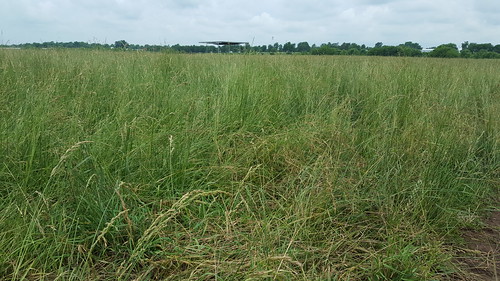Summer turns up heat for ranchers to aggressively manage fescue
By Mary Hightower
U of A System Division of Agriculture
June 10, 2016
Fast facts:
- Cool-season Kentucky 31 fescue has advantages, but can prevent optimal gains
- Novel endophyte fescue can persist on par with Kentucky 31
(371 words)
(newsrooms: with art at https://www.flickr.com/photos/uacescomm/27494799766 and www.flickr.com/photos/uacescomm/27529204535 )
FAYETTEVILLE Ark. – When summer turns the heat up, ranchers in the fescue belt need to manage pastures more aggressively.
“Kentucky 31 comes with a host of advantages, including persistence under grazing, its relatively low fertilization needs and because it’s a cool-season grass, has good stockpiling potential,” said Dirk Philipp, associate professor-Animal Science, for the University of Arkansas System Division of Agriculture.
Kentucky 31 fescue is also infected with a fungus called an endophyte which can, under certain conditions, increase alkaloids in the forage that can have negative impacts on animal health, including “raised body temperatures whose effects are exacerbated in hot fescue-belt summers,” he said.
Hot cattle tend to “constantly seek shade and spend less time grazing, and thus overall gains are reduced,” Philipp said, adding that the shade-seeking behavior may “contribute to environmental degradation by spending more time in creeks and degrading buffer areas around streams.”
Philipp said there are strategies for alleviating fescue toxicity in the short term:
- Avoid seedhead grazing by cattle. This can be accomplished by trying to maintain fescue in the vegetative stage via grazing or clipping seedheads with a bush hog.
- Don’t over-fertilize fescue. Philipp said growers should go strictly by soil test recommendations and avoid nitrogen rates higher than 70 pounds per acre in spring.
- Keep cattle cool. Providing shade structures can help cattle stay cool. Moveable structures are ideal, and while these are not inexpensive, they can last a lifetime and provide a return on investment.
In the long term, Philipp said, consider switching from Kentucky 31.
“An overwhelming body of scientific evidence shows that novel endophyte fescue results in higher gains than Kentucky 31 due to the lack of a toxic alkaloid production,” he said. “Despite the prevailing perception about lesser persistence, novel endophyte fescue plant persistence and grazing persistence is not only on par with the toxic fescue if management recommendations are followed.”
Among the advantages of the novel endophyte fescue: the seedheads are not toxic.
Philipp said old fescue stands can be converted to novel endophyte fescue at smaller rates, such as 25 percent of the total area, then another 25 percent a few years late.
Novel endophyte fescue will not become infected by Kentucky 31 and “will only thin out if Kentucky 31 plants remain and the pasture is completely ill-managed,” Philipp said.
For more information about forages, visit www.uaex.uada.edu or contact your county extension office.
Pursuant to 7 CFR § 15.3, the University of Arkansas System Division of Agriculture offers all its Extension and Research programs and services (including employment) without regard to race, color, sex, national origin, religion, age, disability, marital or veteran status, genetic information, sexual preference, pregnancy or any other legally protected status, and is an equal opportunity institution.
# # #
Media Contact: Mary Hightower
Dir. of Communication Services
U of A Division of Agriculture
Cooperative Extension Service
(501) 671-2126
mhightower@uada.edu
Related Links
